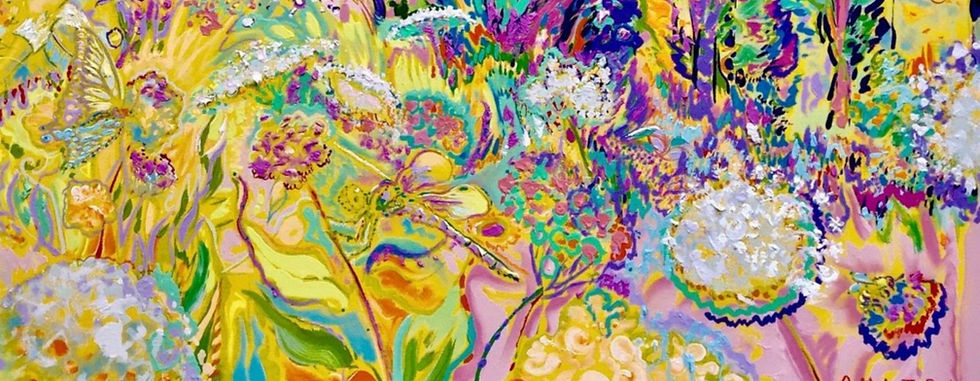Creating Your Own Impressionist Palette
- Dmitri Wright
- Apr 30
- 4 min read
Updated: May 1
The Impressionists’ palettes evolved differently than their Academy predecessors, the latter being generated by the craft guilds via the master to student tradition. The Impressionists’ palettes were revolutionary and simple in comparison to the maximized palettes of the Old Masters and even to the contemporary palettes often used today.
Impressionist paintings reflected a radical break with traditional notions about color and painting. Impressionist artists were inspired by the innovations in color manufacturing. This coincided with the new optical theories which affected how they perceived light as color, color as light. This confluence of theory, material, and methods helped to generate the Impressionist chromatic palette.
Your palette is what dreams are made of
The selection of colors and how they are arranged and applied on the picture plane imparts the individuality of the artist. As we look at the paintings of Monet in relation to Morisot or Cassatt from Pissarro, each had their own unique selections. Their artworks are not just different because of brushwork and subject matter but because of their palette.
Your palette is your brand
Most students inherit their palettes from their teachers, mentors or schools of thought. Therefore, it is important to create your own palette for that becomes your brand. There are two schools of thought as to how many colors are necessary or ideal. The first is a maximized palette with a range of ten or more colors. The second is a minimal palette than can include up to ten colors.
Regarding a maximum palette the key idea is the more colors that the artist has available the more likely they’re able to have the effect that is desired to some extent. There is more room for disharmony.
For plein air painting gently artists want to travel light. For my own work a limited palette is more targeted and specific to obtain the vibration of color opposites with broken space brushstrokes to have the piece come alive.

Palette arrangements
Analogous to keys on a piano, the artist’s palette is to be arranged. High notes moving to low notes - lighter colors moving to darker colors. Or have your Golden Color at the center and work your way from there. Arrange your colors along the edge of your palette according to your desired selections.
It was not unusual for an Impressionist to have a different palette setup for different subjects. The palette for landscape and figure and interior and exterior settings call for different sets of colors. In due course, each artist must decide on a spectrum array of colors based upon his or her own personality and temperament.
For the plein air artist, color can come more naturally to those whose clothes are being faded by the sun. When you are out there in the thick of it not as a spectator but as the artist breathing in the surroundings, that is where you should select and set up your palette.
Captivating your subject can be fleeting in the light. Therefore, choose a limited palette as a matter of habit or perhaps have your painting Basically, Impressionist artists have a choice when it comes to a color palette. There is a limited pallet and a maximum pallet for the most part impressionists will use a limited palette.
Personalize your palette
Select your favorite color, which I call your ‘Golden Color’. Place it at the center of your palette then select other colors that complement it.
Minimal palette
Impressionists palettes are minimal and for good reason. Impressionist painters simply wanted to do more with less. The way they selected, arranged, used, and applied pigments to the canvas was totally different and new because they were after a new way of seeing their world.
Impressionist painters used brushy broken-spaced vibrant colors, simultaneous contrast, and optical mixing to achieve their goals. Impressionist painters today can achieve the same luminosity and vibrancy in their work by optically mixing colors as light effects using pigments directly. A limited palette is not limited for an Impressionist.
A limited palette consists of about 5 to 7 colors basically a maximum pallet will be anywhere from 10 to more colors. This is not a hard and fast rule but there’s some foundation to this idea.
Limited pallets are more targeted and they work within the color harmonies of the sensations and the moment. The colors selected need to consider optical mixing and simultaneous contrasting. In this way a limited palette gives way to wider expression of color.
The classic limited palette is composed of color opposites such as red and green blue and orange yellow and purple that could be a basic limited palette for an impressionist.
The natural impressionist palette has a tendency to be focused upon light time of day season and how the artist century awareness of these moments come together to produce an image. A post-impressionist will use the limited palette based upon what their heart is saying or what their imagination can conjure up.
Maximized palette
This palette presents the artist color options beyond primary, secondary, and even tertiary colors displayed on the RYB color wheel. Tints and shades, browns and blacks, including specialty or boutique colors will afford the artist greater opportunities. In this view, one needs to seek the right color for the right job.
It should be noted that the Impressionist painters experimented with a range of pigments, ultimately refining to a more minimal palette. This was based on a clear set of aesthetic preferences.



Comments